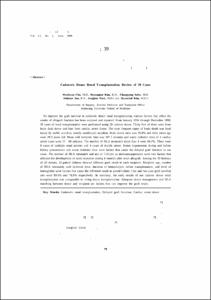사체신장이식; 39예의 임상분석
- Keimyung Author(s)
- Cho, Won Hyun; Kim, Hyoung Tae; Park, Sung Bae; Kim, Hyun Chul
- Journal Title
- 대한이식학회지
- Issued Date
- 1999
- Volume
- 13
- Issue
- 1
- Abstract
- To improve the graft survival in cadaveric donor renal transplantation, various factors that affect the results of allograft function has been analysed and reported. From January 1994 through December 1998, 39 cases of renal transplantation were performed using 20 cadaver donor. Thirty five of them were from brain dead donor and four from cardiac arrest donor. The most frequent cause of brain death was head injury by traffic accident, mostly autobicycle accident. Male donor ratio was 85.0% and their mean age were 29.3 years old. Mean cold ischemic time was 347.5 minutes and warm ischemic time of 4 cardiac arrest cases were 55∼60 minutes. The number of HLA mismatch more than 4 were 64.1%. There were 8 cases of multiple renal arteries and 4 cases of double ureter. Donor hypotension during and before kidney procurement and warm ischemic time were factors that cause the delayed graft function in our cases. The number of HLA mismatch and use of Cellcept as immunosuppressant were two factors that affected the development of acute rejection during 6 months after renal allograft. Among the 39 kidneys of 20 donors, 12 paired kidneys showed different graft result in each recipient. Recipient age, number of HLA mismatch, cold ischemic time, duration of hemodialysis before transplantation, and level of hemoglobin were factors that cause the diffrerent result in paired kidney. One and two year graft survival rate were 89.6% and 76.5% respectively. In summary, the early results of our cadaver donor renal transplantation was comparable to living donor transplantation. Adequate donor management and HLA matching between donor and recipient are factors that can improve the graft result.
1994년 1월 이후 1998년 12월까지 본원 신이식팀에서 사체신이식을 시행한 39예의 환자를 분석하여 다음의 결과를 얻었다. 기증자의 대부분이 교통사고에 의한 뇌손상환자였고 20대 전후의 젊은 연령층이 많았다. 평균 냉무혈시간은 347.5분이었고 조직적합성 항원이 4개 이상 비일치한 경우가 64.1%로 나타났다. 이식신의 지연성 기능장애와 관계있는 인자는 기증자의 저혈압, 온무혈시간이었고, 조직적합성 항원의 불일치정도가 거부반응을 일으킨 환자들에게 의의있게 높았다. 같은 기증자로부터 기증된 두 개의 신장이 수혜자에서 서로 다른 결과를 나타낸 경우가 12예있었는데 이들 사이에는 수혜자 연령, 조직적합성 항원의 불일치정도, 냉무혈시간, 이식전 투석기간, 혈색소치 등이 차이를 나타냈다. 사체신이식 환자의 1년 및 2년 생존율은 89.6% 및 76.5%였다.
- Alternative Title
- Cadaveric Donor Renal Transplantation; Review of 39 Cases
- Publisher
- School of Medicine
- Citation
- 조원현 et al. (1999). 사체신장이식; 39예의 임상분석. 대한이식학회지, 13(1), 79–86.
- Type
- Article
- ISSN
- 1598-1711
- Appears in Collections:
- 1. School of Medicine (의과대학) > Dept. of Internal Medicine (내과학)
1. School of Medicine (의과대학) > Dept. of Surgery (외과학)
- 파일 목록
-
-
Download
 oak-bbb-03256.pdf
기타 데이터 / 87.24 kB / Adobe PDF
oak-bbb-03256.pdf
기타 데이터 / 87.24 kB / Adobe PDF
-
Items in Repository are protected by copyright, with all rights reserved, unless otherwise indicated.